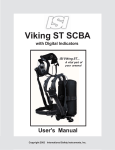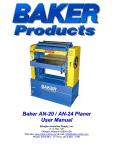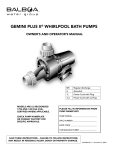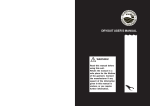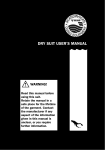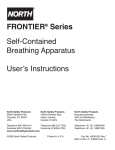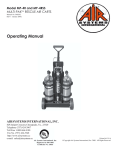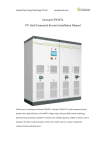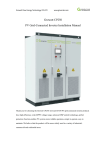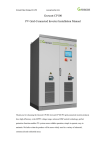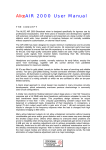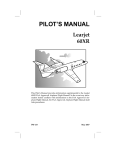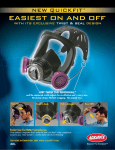Download Users Manual s Manual
Transcript
Frontier Self Contained Breathing Apparatus User s Manual Users User's Manual for the FR ONTIER FRONTIER Self Cont ained Breathing Apparatus Contained MODELS Frontier, 2216 psi, 30 minute NIOSH approval TC-13F-491 Frontier, 4500 psi, 30 minute NIOSH approval TC-13F-492 Frontier, 4500 psi, 45 minute NIOSH approval TC-13F-493 Frontier, 4500 psi, 60 minute NIOSH approval TC-13F-494 WARNING Disassembly of the components beyond the procedures described herein shall not be performed. Additional disassembly may cause component damage and shall only be performed by authorized personnel or the factory. INTEC Controls, Inc. 9730 Distribution Ave. San Diego, CA 92121 ph: (858) 578-7887 fx: (858) 578-4633 www.inteccontrols.com [email protected] Part Number: 084062 Artwork Number: A49095 Issue B Issue B August 22, 2002 August 22, 2002 TABLE OF CONTENTS PREFACE-IMPORTANT POINTS Intent Training NIOSH Warnings Cautions & Limitations Special or Critical User Instructions 1.0 1 1 1 1 2 2 DESCRIPTION OF FRONTIER 2 1.1 1.2 1.3 1.4 1.5 1.6 1.7 2 3 3 3 3 3 4 6.0 7.0 8.0 2.0 3.0 4.0 5.0 Facemask or Hood Compact Demand Valve First Stage Pressure Reducer End-of-service Alarms Backframe and Harness Cylinder and Valve Assembly Frontier Cylinder Table ROUTINE CHECKS 4 2.1 2.2 2.3 Unpacking Inventory and Examination Routine Checks and Inspections 4 4 4 DONNING PROCEDURES AND SAFETY CHECKS 6 3.1 3.2 6 7 Donning Procedures Safety Checks DURING USE 8 4.1 4.2 8 9 Normal Use Emergency Egress Indicators AFTER USE PROCEDURES 9 5.1 9 Doffing 9.0 10.0 AFTER USE CLEANING 9 6.1 6.2 9 10 Clean Facemask Cleaning SCBA SCBA STORAGE 10 7.1 SCBA Storage 10 USER MAINTENANCE 10 8.1 8.2 8.3 8.4 10 11 12 13 Cylinder Filling Procedures Facemask Disassembly & Reassembly Facemask Harness Replacement Backframe Harness FRONTIER OPTIONS 13 9.1 9.2 13 14 Airline Buddy Breather TROUBLESHOOTING GUIDE 15 PREFACE IMPORTANT POINTS - PLEASE READ CAREFULLY FAILURE TO PROPERLY USE AND MAINTAIN THIS PRODUCT COULD RESULT IN INJURY OR DEATH INTENT This manual is intended to acquaint owners and users with operation for the FRONTIER Self-Contained Breathing Apparatus and to provide important safety information and limitations. All information, illustrations and specifications in this manual are based on the latest product information available at the time of printing. The right is reserved to make changes at any time without notice. IMPORTANT ALL PERSONNEL USING THIS APPARATUS SHALL BE THOROUGHLY TRAINED BY A QUALIFIED INSTRUCTOR IN DONNING, OPERATION, INSPECTION AND EMERGENCY OPERATION. EQUIPMENT SHOULD BE THOROUGHLY CHECKED AND CLEANED AFTER EXPOSURE TO INTENSE HEAT OR HARSH CHEMICALS. The FRONTIER pneumatics are designed to be simple to use and easy to maintain and will operate for many years if properly maintained and cleaned. The instructions for care and use given in this manual must be read, understood and carefully followed before the apparatus is used. The procedures in this manual DO NOT render us liable for any losses or injury arising from any actions based on use of same. Spare parts and accessories are available through your local authorized distributor. Suggested spare parts from other sources will void NIOSH approvals. Service beyond the scope of this manual is not recommended. If a problem persists, the apparatus should be removed from service, tagged for repair and forwarded to an authorized distributor or to the factory for evaluation and/or repair. TRAINING We strongly recommends that the training program be consistent with Occupational Safety and Health Programs. Training and servicing programs are available upon request. Please contact your local distributor for further details. NIOSH/OSHA WARNINGS The following warnings are given in accordance with accepted safety conventions and/or NIOSH/OSHA requirements, and apply to the use of breathing apparatus in general. HEALTH LIMITATIONS: Wearers of SCBA should be certified medically fit prior to use. In addition, there are both physiological and psychological limitations which should be considered before using SCBA. They include, but are not limited to: * * * * * * * * * * * * * * Emphysema Chronic obstructive pulmonary disease Bronchial asthma X-ray evidence of pneumonia Evidence of reduced pulmonary function Coronary artery disease Severe or progressive hypertension Epilepsy (grand mal or petit mal) Pernicious anemia Diabetes (insipidous or mellitus) Breathing difficulties when wearing an SCBA Claustrophobia or anxiety when wearing an SCBA Abnormal EKG results from resting or stress tests Punctured or ruptured ear drum WORKING TEMPERATURES: FRONTIER is approved for respiratory protection during entry into or escape from oxygen deficient atmospheres, gases, and vapors at temperatures above -25°F. When used below freezing, care must be exercised to prevent moisture from entering the demand and exhalation valves. This includes when cylinders are being changed. DURATION OF USE: Although the FRONTIER has been approved as either a 30-minute, 45-minute, or 60-minute breathing apparatus, the wearer’s varying work rate, physical condition and other factors could substantially shorten the actual usable duration of the unit. SCBA LIMITATIONS: SCBA can only protect the wearer’s respiratory system. Other protection may be necessary to avoid contamination through skin absorption. If these types of materials are suspected, an effective full-body covering of impermeable material must be worn with the SCBA. A universal Class A HazMat suit pass through is available for the FRONTIER from us or HazMat suit manufacturers. FACIAL HAIR: Facial hair or any items which may interfere with the seal surface, or in the operation of the exhalation valve, must not be allowed. These include beards, sideburns, mustaches, bangs, head coverings, or anything that may interfere with the correct seal of the facemask to the face. An optional hood is also available for those with facial hair. EYE WEAR: Eye glasses shall not be used when the temple bars interfere with the proper seal of the facemask to the face. If a user must wear corrective lenses while wearing the SCBA, they can be mounted in the facemask using a special lens mounting kit available from us or through your local distributor An optional hood is also available that allows the user to wear glasses with temple bars. MANUAL BYPASS: The FRONTIER has a manually operated bypass which provides a continuous flow of air to the facemask when required, independent of normal operation of the regulator. The bypass is opened by turning the red knob on the Compact Demand Valve 90 degrees. 1 CAUTIONS AND LIMITATIONS SPECIAL OR CRITICAL USER’S INSTRUCTIONS • Airline respirators can be used only when the respirators are supplied with respirable air meeting the requirements of CGA G7.1 Grade D or higher quality. Use only the pressure ranges and hose lengths specified in the User’s Instructions. • Approved for respiratory protection during entry into or escape from oxygen deficient atmospheres, gases and vapors at temperatures above -25°F. • • Failure to properly use and maintain this product could result in injury or death. • All approved respirators shall be selected, fitted, used, and maintained in accordance with OSHA and other applicable regulations. Approved only when compressed gas container is charged with air meeting the requirements of CGA G-7.1 Grade D or higher quality that has a dew point of -65°F or lower and a maximum particulate level of 5 mg/m3 air. • The compressed gas container shall meet applicable DOT specifications. • When used as a combination apparatus, only 20% of the service pressure may be used on entry. • This approval applies only when the device is supplied with respirable breathing air through 6 to 300 feet of hose at air pressures between 80 to 120 pounds per square inch gauge or from self contained air supply. • If the supplied air fails, open the cylinder valve and proceed to fresh air immediately. • Use adequate skin protection when worn in gases and vapors that poison by absorption (example: hydrocyanic-acid gas). • Never substitute, modify, add, or omit parts. Use only exact replacement parts in the configuration as specified by the manufacturer. Do not mark the unit with inks or paints which might be flammable; vibratory etching may be used on all parts except the visor and cylinder. • Refer to User’s Instructions and/or maintenance manuals for information on use and maintenance of these respirators. • Special or critical User’s Instructions and/or specific use limitations apply. Refer to User’s Instructions before donning. 1.0 DESCRIPTION OF FRONTIER SCBA FACEMASK 1.1 HOOD FACEMASK OR HOOD The full facemask assembly has a four-point adjustable head harness. The interior of the visor can be purchased with an optional permanent anti-fog coating. The facemask standard seal has a blended shape to ensure a proper fit. A standard inner-mask nosecup reduces dead-air space and CO2 buildup. The FRONTIER is a self-contained, open-circuit, compressed-air breathing apparatus that is approved by the National Institute of Occupational Safety and Health (NIOSH). Positive pressure is maintained within the facemask during use, thus providing the highest degree of respiratory protection in irrespirable atmospheres by preventing any inward leakage. The FRONTIER consists of several major components described in the following paragraphs: 2 The Hood is also available for users that prefer to wear their own eyeglasses or may have facial hair that may interfere with the sealing surface. The sealing surface of the hood is around the neck. The sealing surface must not have any hair interfering with the neck seal. The Hood is NIOSH approved for entry into an IDLH atmosphere. The Hood has a hard visor with a permanent anti-fog coating that offers excellent vision, an inner nosecup to reduce CO2 build-up, and adjustable side straps for a comfortable fit. The Hood is available in two sizes to comfortably fit any person. 1.5 1.2 BACKFRAME AND HARNESS COMPACT DEMAND VALVE (CDV) The patented Compact Demand Valve regulator combines high flow with a low profile to improve mobility. The CDV exhalation valve greatly reduces breathing resistance which allows for longer duration of cylinder use. The CDV is easily docked into the facemask using a threaded handwheel. The backframe and harness assembly utilize ergonomic design principles to produce a comfortable, low profile unit that evenly distributes the SCBA weight between the wearer’s hips and shoulders. A quick-release cylinder band fits a wide range of cylinders with an infinitely adjustable strap to ensure a tight fitting cylinder. The harness material is a custom woven Nylon with easy slide shoulder buckles allowing for quick donning of the Frontier SCBA. Also available are the optional Kevlar straps and shoulder pads. 1.6 1.3 FIRST STAGE PRESSURE REDUCER Air leaves the cylinder, passes through a sintered bronze filter in the handwheel assembly, and then continues on to the first-stage pressure reducer where it is reduced to approximately 125 psi. The reducer is a simple piston type that requires no adjustment and incorporates an automatic, selfseating pressure relief valve to protect the downstream lowpressure components. It is made of high quality aluminum, and is securely mounted to the cylinder. REMOTE CYLINDER PRESSURE AND ENDOF-SERVICE TIME INDICATORS 1.4 The remote pressure gauge and whistle assembly is chest mounted on the right shoulder strap. The pressure gauge is waterproof with a neoprene protective cover and features a luminous dial and pointer markings. The gauge display shows the fraction of cylinder pressure remaining. CYLINDER AND VALVE ASSEMBLY A range of cylinder types and capacities are accommodated on the FRONTIER 2216 psi and 4500 psi models. (Please see the table in Section 1.7 for specifics.) The cylinder valve is of forged aluminum construction with a permanent teflon coating. The valve outlet is a standard CGA-346 fitting on 2216 psi cylinders, and a standard CGA347 fitting on 4500 psi cylinders. Each valve has a frangible disc safety relief device, and a dual-reading pressure gauge. Valve protection is provided by an elastomeric bumper. HANDLING PRECAUTIONS: NEVER LIFT OR CARRY UNIT BY THE FACEMASK HOSE OR GAUGE ASSEMBLY. IF A HOSE BECOMES KINKED OR OTHERWISE DAMAGED, IT SHOULD BE REPLACED. CHECK FOR DAMAGE NEXT TO THE METAL ENDS OF THE HOSE. The primary End-of-Service-Time indicator is a whistle which is set to sound at 23%-27% of rated cylinder pressure per NIOSH requirements. 3 1.7 FRONTIER CYLINDER TABLE Part Number Pressure PSIG Material Free Air Capacity NIOSH Rated Duration @ 40 lpm Cylinder & Valve Charged Weight Cylinder Diameter Hydrostatic Interval 024.037.00 2216 Aluminum 1287 liters 45 cu. ft. 30 min. 20.5 lbs. 6.9 in. 5 years 024.035.00 2216 Hoop-Wrapped Aluminum 1301 liters 45.5 cu. ft. 30 min. 16.0 lbs. 6.9 in. 3 years 124001 2216 Full Wrapped Carbon 1301 liters 45 cu. ft. 30 min. 10.4 lbs. 6.8 in. 5 years 024.098.00 4500 Hoop-Wrapped Aluminum 1287 liters 45 cu. ft. 30 min. 15.9 lbs. 5.5 in. 3 years 124002 4500 Full Wrapped Carbon 1287 liters 45 cu. ft. 30 min. 11.0 lbs. 5.4 in. 5 years 124003 4500 Full Wrapped Carbon 1887 liters 66 cu. ft. 45 min. 14.8 lbs. 6.8 in. 5 years 124004 4500 Full Wrapped Carbon 2516 liters 88 cu. ft. 60 min. 19.2 lbs. 7.1 in. 5 years 2.0 ROUTINE CHECKS 2.1 UNPACKING Open the storage case or shipping container. Observe the relative position and placement of the various components for future re-packing. Remove SCBA from container and place on clean dry surface. Remove facemask from protective bag. 2.2 INVENTORY AND EXAMINATION Examine unit for physical condition and appearance of all components. Be sure the following major components are included: • • • • 2.3 Facemask or Hood Backframe and Harness Assembly Cylinder and Valve Assembly Options ordered with unit ROUTINE CHECKS AND INSPECTIONS The following procedure shall be used for incoming and daily inspection of the apparatus. An SCBA not routinely used, but kept for emergency use, shall be inspected at least monthly. All other apparatus shall additionally be inspected after each use. 4 WARNING THE APPARATUS MUST NOT BE USED UNTIL THE FOLLOWING TESTS HAVE BEEN SUCCESSFULLY COMPLETED. ANY DISCREPANCY NOTED DURING THE PRE-USE CHECK AND INSPECTION SHALL BE CORRECTED ONLY BY AUTHORIZED PERSONNEL PRIOR TO USE OF THE APPARATUS. 2.3.1 Visually inspect complete apparatus for worn or aged parts and damaged components. 2.3.2 Basic cylinder inspection shall include: A. Inspect gauge for damage. B. Inspect cylinder for mechanical damage (cracks, dents, gouges) or signs of heat or chemical damage. (Refer to CGA C-6.2 "Guideline for Visual Inspection and Requalification of Fiber Reinforced High Pressure Cylinders" for all wrapped cylinders.) C. Check that hydrostatic test date on cylinder is current. D. Check that cylinder valve threads are not damaged. E. Check that the valve body is not bent. F. Check that the burst disc outlet is clean and free of debris. G. If any item listed above is noted, depressurize cylinder to a slight positive pressure, tag, and take out of service. 2.3.3 Connect the CDV to the FRONTIER facemask or hood by screwing the CDV handwheel into the hood or facemask. Make sure the manual red bypass knob is in the closed position, i.e., fully turned clockwise. 2.3.4 Open the cylinder valve slowly by turning the cylinder valve knob counter-clockwise to the fully open position. Hold facemask tight to your face. The whistle alarm should activate and then shut off. There should be no air flow from the facemask. If air is flowing, check that bypass is closed. 2.3.7 To test the Hood for positive pressure, Insert two fingers between the seal and neck. Gently lift the seal away from the neck while pulling the nosecup away from the face. A good outward flow of air should be felt. Reseal the hood and stop breathing for three seconds. There should be no sound of air leaking from the CDV. Open the bypass knob and check for a constant flow. Close the bypass knob. 2.3.8 Low Pressure Alarm Test: Close cylinder valve and gradually reduce the pneumatics by opening the bypass to slowly vent the air. Check to see that the whistle "End-of-Service" alarm activates as the needle enters the red section of the gauge (1/4 marking). 2.3.9 Unscrew the CDV from the facemask or hood from the SCBA by turning counterclockwise and pulling the CDV out of the facemask. 2.3.10 Leak Test of SCBA: With the CDV disconnected from the facemask or hood, open the cylinder valve and place the test cap over the CDV outlet port. Do not seal with test cap until air flow has begun. Allow the pneumatics to pressurize and then close cylinder valve. Lightly place a finger over the hole in the test cap to restrict air flow. The needle on the pressure gauge should not fall more than 1/8 inch per minute. Remove the test cap to drain pneumatics. Note: The CDV flows a very small amount of air past the pilot jet. The test cap has a small hole to allow the air to escape. It may be necessary to hold the test cap in place while performing the leak test. 2.3.11 Connect CDV to the facemask or hood. Pull gently outward on the CDV to ensure it is docked properly. 2.3.12 Return apparatus to storage, or proceed to donning instructions. WARNING ENSURE THAT ONLY A 2216 PSI CYLINDER IS USED WITH LOW PRESSURE PNEUMATICS AND A 4500 PSI CYLINDER IS USED WITH HIGH PRESSURE PNEUMATICS. 2.3.5 2.3.6 CHECK CYLINDER PRESSURE Remote cylinder pressure gauge should read above 7/8 of maximum rated pressure. If cylinder pressure reads 7/8 or less, refill or replace with a fully charged cylinder. While holding the facemask tight to your face, insert two fingers between the facemask and face. Gently lift the seal away from the face and ensure a good outward flow of air. Reseal the facemask and stop breathing for three seconds. There should be no sound of air flowing. Open the optional bypass knob and check for a constant air flow. Close bypass knob. IMPORTANT COMPLETE ALL ROUTINE CHECKS AND INSPECTION PROCEDURES OUTLINED IN SECTION 2 BEFORE STARTING DONNING PROCEDURES, SECTION 3. WARNING IF ANY OF THE ABOVE TESTS FAIL, REMOVE APPARATUS FROM SERVICE, TAG, AND RETURN FOR REPAIR BY AUTHORIZED PERSONNEL. TECHNICIAN MAINTENANCE 5 3.0 DONNING PROCEDURES AND SAFETY CHECKS AFTER EVERY 100 HOURS OF USE, OR AT LEAST ONCE PER YEAR, THE ENTIRE SCBA SHOULD BE PLACED OUT OF SERVICE AND TAGGED FOR COMPREHENSIVE MAINTENANCE BY AUTHORIZED TRAINED TECHNICIAN. 3.1 DONNING PROCEDURES 3.1.1 Position the FRONTIER on the ground with the cylinder valve facing towards the wearer. 3.1.2 3.1.3 6 3.1.4 Pull directly down on the shoulder straps to adjust position of unit on back. 3.1.5 Connect the waistbelt buckle and adjust waistbelt to a comfortable snug fit. Tuck the excess waistbelt and shoulder strap pull-downs inside the waistbelt. 3.1.6 Donn facemask. Adjust the spider by pulling back on the lower straps first before adjusting the top straps. Spread the shoulder straps apart. Ensure all strap assemblies, side and waist, are fully extended and waist belt buckle assembly is not connected. Grasp the left shoulder strap with your left hand. Lift the FRONTIER onto your left shoulder. Place your right arm through the right shoulder strap. 3.1.7 Donn Hood. To donn hood, place your hands inside the neckseal opening and spread apart. Do not use your fingertips to spread neckseal apart as the fingernails may puncture the seal. Also note, sharp rings can tear the neck seal. Place chin into the opening and pull hood over the head. Adjust the nosecup over the mouth and nose and tighten the side straps by pulling forward. Ensure the neckseal lays flush against the neck and that no hair or other items pass between the skin and neckseal. Open cylinder valve slowly by turning counter-clock- wise to the full open position. The whistle should activate when opening the cylinder valve. Air should be flowing out of the CDV. FACEMASK 3.1.8 HOOD Rotate and pull outward to ensure CDV is not cross threaded into the facemask or hood. 3.1.10 With the CDV secure, the whistle should then shut off. 3.1.11 If the CDV is already docked to the hood or facemask prior to donning, open the cylinder valve prior to donning. Once the hood or facemask is donned, ensure that the CDV is properly docked by rotating and pulling outward. IMPORTANT DO NOT OVER-TIGHTEN THE FACEMASK. DOING SO MAY CAUSE DISCOMFORT OR FACEMASK DEFORMATION AND LEAKAGE. SAFETY CHECKS WARNING THESE SAFETY CHECKS MUST BE PERFORMED BEFORE ENTERING A HAZARDOUS AREA. FAILURE TO PERFORM THESE CHECKS MAY RESULT IN RESPIRATORY INJURY OR DEATH. 3.2.1 Note: It is not necessary to perform a negative pressure check because the CDV and facemask are designed as a positive pressure facemask or hood. 3.2.2 ALARM CHECK: Close the cylinder valve and continue to breathe normally. Monitor pressure gauge and listen for the whistle to activate as the gauge needle enters into the red zone. Open cylinder valve fully. 3.2.3 Take two to three deep breaths to ensure you are getting adequate air into the facemask. The facemask should not move towards your face. 3.2.4 OPTIONAL BYPASS CHECK The red bypass knob is located on the right side of the CDV. Turn the bypass knob clockwise to open the bypass valve. A constant flow of air should pass into the facemask. Turn the knob in the opposite direction to turn the bypass valve off. 3.2.5 RE-CHECK CYLINDER PRESSURE Check the pressure gauge on the right shoulder harness. The gauge should read above 7/8 FULL (more than halfway between 3/4 and FULL). Breathe normally and proceed as planned. Attach the CDV into the facemask or hood. 3.1.9 3.2 of air leaking from the AirSwitch regulator, and there should be no airflow sensed in the eye region of the mask. POSITIVE PRESSURE FIT CHECK: With cylinder valve open, breathe normally. Insert two fingers between the facemask and face. Gently lift the facemask seal away from the face and ensure a good outward flow of air, showing that the facemask pressure is positive. Reseal facemask and stop breathing for 3 seconds. There should be no sound WARNINGS: IF ANY OF THE ABOVE CHECKS FAIL, DO NOT PROCEED. REMOVE THE APPARATUS FROM SERVICE, TAG, AND RETURN FOR REPAIR BY AUTHORIZED PERSONNEL. USE OF THE OPTIONAL BYPASS IN NON-EMERGENCY SITUATIONS WILL SUBSTANTIALLY REDUCE DURATION OF THE APPARATUS. THE BYPASS WILL NOT FUNCTION IF THE CYLINDER IS OUT OF AIR. IMPORTANT THE USER SHOULD HAVE RECEIVED TRAINING ON HOW TO HANDLE A POSSIBLE EMERGENCY BEFORE ENTERING A HAZARDOUS AREA. 7 4.0 DURING USE 4.1 NORMAL USE 4.1.1 Monitor cylinder pressure during use for remaining air supply and allow sufficient time for egress. 4.1.2 The End-of-Service-Time indicator (whistle alarm) activates when there is approximately 25% of the full air supply remaining. Egress when alarm activates. WARNING: 25% OF A FULL CYLINDER MAY BE INSUFFICIENT IN SOME CIRCUMSTANCES TO SAFELY EXIT FROM AN IDLH ATMOSPHERE. One example would be a long-distance ingress through a continuous IDLH (Immediately Dangerous to Life or Health) atmosphere. In such situations, begin egress prior to activation of the End-of-ServiceTime indicator. 4.1.3 4.1.3.4 Insert new full cylinder by sliding down through cylinder band until cylinder rests against bottom retainer. INSTRUCTIONS FOR CHANGING CYLINDERS 4.1.3.1 Make sure cylinder valve is closed and all air is released from the pneumatic system. 4.1.3.5 Connect handwheel to cylinder valve and position cylinder. 4.1.3.6 Close the locking latch. 4.1.4 CYLINDER BAND ADJUSTMENT 4.1.4.1 Make sure cylinder valve is closed and air is released from the pneumatic system. 4.1.3.2 Pull outward the center of the locking latch to relieve cylinder band tension. 4.1.4.2 Pull outward on latch to relieve cylinder band tension. 4.1.3.3 Disconnect handwheel from cylinder valve and remove cylinder by sliding cylinder upward through cylinder band. 4.1.4.3 To loosen the cylinder band, slide the outer cylinder band strap towards the locking latch and pull the inner strap to enlarge strap opening. 8 To tighten the cylinder band, grab the outer cylinder 4.2 band strap and pull up/away from the adjustment latch. Slide the slack across the inner strap. Slide the slack away from the latch, across the cylinder. Do not over tighten the strap. 4.1.4.4 Connect handwheel to cylinder valve and position cylinder. 4.1.4.5 Close the locking latch. EMERGENCY EGRESS INDICATORS If any of the following situations occur, egress immediately: A. Exposure to flashover B. Exposure to high temperature C. Harness failure D. Chattering or unusual noises from SCBA E. Submersion in water (Note: In this situation the FRONTIER will continue to supply air on demand to a depth of at least 3 meters.) F. SCBA subjected to high impact such as a fall G. Air flow decreases such that the facemask moves inward toward the face during inhalation (Note: In this situation, open bypass to provide extra, constant flow.) H. Air flows constantly at a high rate (Note: In this situation, adjust the flow rate by slowly closing the cylinder valve until a comfortable flow rate is established. The flow rate should match the bypass flow rate during normal operation.) I. Exposure to unknown gases or chemical that may require the use of a Class "A" suit. 5.0 AFTER USE PROCEDURES IMPORTANT DO NOT REMOVE ANY EQUIPMENT UNTIL YOU ARE CLEAR OF AN IDLH ATMOSPHERE. 5.1 DOFFING 5.1.1 Loosen head straps fully. Air should start to free flow from the facemask. Take a deep breath. 5.1.2 Close the cylinder valve by turning it fully clockwise. 5.1.3 Remove facemask. 5.1.4 Remove hood by placing both hands under the neck seal and lift hood over the front of your face. 5.1.5 Unfasten the waistbelt and loosen shoulder straps. Extend shoulder straps and waistbelt fully. 5.1.6 Remove the apparatus. 5.1.7 Remove the cylinder and tag it for refilling. See Section 8 for instructions. 5.1.8 Do not store or place apparatus in ready position until after performing “After Use Cleaning” Section 6. 6.0 AFTER USE CLEANING TO AVOID DAMAGE TO THE VISOR, DO NOT PLACE THE FACEMASK DOWN ON ROUGH SURFACES. 6.1 6.1.1 CLEANING FACEMASK Disconnect the CDV from the facemask or hood by turning the handwheel on the CDV counterclockwise and then remove the CDV. Wash the facemask or hood in cool to warm soapy water for no more than 10 minutes. Use a mild, non-detergent, dishwashing soap (e.g. Ivory). NOTE CDV CANNOT BE RUN UNDER WATER. 6.1.2 Rinse thoroughly in clean running water, allowing the water to flow through the facemask. 6.1.3 After rinsing, shake to remove excess water. Wipe dry with a soft, clean cloth. NOTE WHERE FURTHER CLEANING DUE TO HEAVY CONTAMINATION IS REQUIRED, CLEAN WITH RECOMMENDED DISINFECTANT/CLEANER (P/N 013003) AFTER RINSING THE FACEMASK OR HOOD. USE OF OTHER DISINFECTANTS MAY CAUSE DAMAGE TO SCBA COMPONENTS. 9 6.1.4 Ensure all head harness straps are fully extended, ready for use. WARNING IF THE APPARATUS IS LIKELY TO BE STORED AT TEMPERATURES BELOW FREEZING (32°F), THE FACEMASK OR HOOD MUST BE THOROUGHLY DRIED. 6.2 CLEANING THE SCBA 6.2.1 Fully extend shoulder straps and waistbelt to full open position. Clean off any dirt with a medium bristle brush or sponge and a mild, non-detergent dishwashing soap. DO NOT USE BLEACH OR ANY COMPOUND CONTAINING CHLORINE AS THIS WILL TEND TO RAPIDLY DETERIORATE FABRIC. CAUTION IF IT IS NECESSARY TO CLEAN THE EXTERIOR OF THE CDV, CARE SHOULD BE TAKEN TO ENSURE NO TRACE AMOUNTS OF WATER ARE LEFT IN THE CDV OPENING. CONNECT UNIT TO FULL CYLINDER AND BLOW WATER OUT, PARTICULARLY IF THE APPARATUS IS TO BE USED OR STORED AT TEMPERATURES BELOW FREEZING. WARNING DO NOT IMMERSE PNEUMATICS IN WATER. PERFORM ALL TESTING AND MAINTENANCE WORK IN A CLEAN ENVIRONMENT. 7.0 SCBA STORAGE 7.1 SCBA STORAGE 7.1.1 Complete routine checks and inspection procedures outlined in Section 2.3 of this manual. 7.1.2 Ensure that complete apparatus is clean and dry. 7.1.3 Ensure that the bypass knob is in the CLOSED position. 7.1.4 Ensure that the head harness straps are fully extended on the facemask. Plug CDV into the facemask or hood assembly and store in case, positioned to avoid distortion. 8.0 Ensure that shoulder and waistbelt straps are fully extended. 7.1.6 Place the complete apparatus in the storage case or suitable storage place so it can be easily reached for emergency use. 7.1.7 MOUNTING SCBA: When storing SCBA using mounting brackets, ensure that brackets are secure and that no sharp objects will come in contact with SCBA or cylinder. USER MAINTENANCE 8.1 CYLINDER FILLING PROCEDURES 8.1.1 Basic cylinder inspection shall include: A. Inspect gauge for damage. B. Inspect cylinder for mechanical damage (cracks, dents, gouges) or signs of heat or chemical damage. (Refer to CGA C-6.2 "Guideline for Visual Inspection and Requalification of Fiber Reinforced High Pressure Cylinders" for all wrapped cylinders.) C. Check that hydrostatic test date on cylinder is current. D. Check that cylinder valve threads are not damaged. E. Check that the valve body is not bent. F. Check that the burst disc outlet is clean and free of debris. G. If any item listed above is noted, depressurize cylinder to a slight positive pressure, tag, and take out of service. 10 7.1.5 NOTE: Cylinders that are tagged for repair should always be stored empty with the cylinder valve closed to prevent contamination or condensation inside the cylinder. 8.1.2 Prior to filling cylinder, follow the basic inspection procedures outlined in 8.1.1 8.1.3 Cylinder air shall meet or exceed the standards in CGA G 7.1 Grade D or higher. 8.1.4 Fill cylinder to maximum rated pressure (FULL). Wait at least 30 minutes to allow cylinder to cool, then add extra air to return to full at room temperature. (Note: pressure drops when cylinder temperature drops.) 8.2 FACEMASK DISASSEMBLY AND REASSEMBLY Tools required: #2 Phillips screwdriver, 2 pin spanner 8.2.5 8.2.1 Remove the two screws from the visor clamps. The nuts may fall out of the lower clamp. Carefully pry the clamps apart and remove from the visor. Remove the CDV adapter using the two pin spanner tool by place spanner tool on the retaining nut and turning counterclockwise. nut seal CDV adapter Remove nut, CDV adapter and gently remove the seal from the visor. 8.2.2 Remove visor from the facemask skirt. 8.2.6 8.2.3 To reassemble, gently install seal into visor, ensuring the seal is flat against the visor on both sides. The seal needs to be orientated so that one detent points to the nosecup. Remove inner nosecup. Lift up slightly and pull away from the exhalation assembly. Install outer CDV connector through the seal and attach retainer nut from inside the mask. 8.2.4 Rotate the exhale valve assembly clockwise until the slots align with the grove in the visor. Push the exhale valve assembly outward. 11 8.2.7 8.2.8 Tighten retainer nut using spanner tool until making contact with the seal. Turn ¼ to ½ turn more using the spanner tool. Check the outside connector is tight by trying to rotate connector. If loose, tighten retainer nut slightly and recheck. Install exhalation valve assembly. There are three notches, one notch is rectangular and the other two are curved. Place the rectangular notch in the upper left-hand corner of the visor. (Do not rotate exhalation valve assembly by the outside cover) Rotate the exhalation assembly from the inside of the visor counterclockwise until the assembly locks in-place. 8.2.10 Install visor into facemask skirt. Gently work the visor into the skirt. Ensure the visor is positioned so the facemask is not distorted. Place a small amount of liquid soap around the attaching area of the visor clamp. Install visor clamp and tighten screws. 8.3 FACEMASK HARNESS REPLACEMENT Note: It is helpful to have a second assembled facemask for referernce during re-assembly. 8.3.1 The harness assembly is a four point harness. Remove harness assembly by pushing forward at each attachment point to align the button with the groove and remove harness from facemask. Repeat at each attachment point. 8.3.2 To remove the spider from the buckle, gently work the spade through the roller. first groove of the exhalation valve 8.2.9 12 Install nosecup over the first groove of the exhalation valve assembly. Start at the bottom and gently seat the nosecup. There are two notches in the nosecup, one at the top and one at the bottom. Rotate slightly to align the notches to seat the nosecup properly. Top Bottom Z pattern 8.3.3 Orientate the new spider so the large opening is aligned near the chin opening of the facemask. 8.3.4 To reinstall, ensure the roller is placed on the inside of the buckle and feed the spade end through the buckle. The end of the spade should facing outward and the ribs should engage the buckle. Repeat on the other three sides. Reinstall spider assembly to facemask ,locking the buttons into the grooves of the buckle. 8.4 BACKFRAME HARNESS 8.4.2 The upper shoulder straps terminate in a “ Z “ pattern. Pull one inch of slack through the backframe, fold the end of the strap tight against the strap and pass the end through the backframe. Repeat on other strap. 8.4.3 Remove waist belt strap in the same manner. Pull one inch of slack and pass the strap through the pathway of the strap. Observe the path prior to removal. 8.4.4 Reverse the steps to reinstall. NOTE IT IS HELPFUL TO HAVE A SECOND BACKFRAME AVAILABLE FOR REFERENCE DURING REASSEMBLY. 8.4.1 Separate lower strap from upper shoulder strap. 9.0 FRONTIER OPTIONS 9.1 AIRLINE Airline Attachment 9.1.1 The Airline Attachment is located on the left waistbelt strap. It is approved with Foster, Hansen HK, and Schrader couplings. Foster, Hansen HK, and Schrader couplings include locking devices. 9.1.2 When using supplied air, the user must ensure that the cylinder valve is closed. Failure to do so may result in reduced cylinder duration. 9.1.3 Airline respirators can be used only when the respirators are supplied with respirable air meeting the requirements of CGA G-7.1 Grade D or higher quality. 9.1.4 When used as a combination apparatus, only 20% of the service pressure may be used on entry. 9.1.5 This approval applies only when the device is supplied with respirable breathing air through 6 to 300 feet of hose at air pressures between 80 to 120 pounds per square inch gauge or from self contained air supply. 9.1.6 Follow Donning Procedures located in Section 3.0 and Safety Checks in Section 3.2. 13 9.1.7 Plug airline hose from Frontier into supplied airline hose. Supplied air pressure shall be between 80 to 120 psi. Close cylinder valve and continue to breathe normally. If supplied air is interrupted, open cylinder valve fully, unplug airline hose and then egress to a safe area. Note: Care must be taken to avoid pulling on the supplied air hose. That may cause hose stress or failure. 9.1.8 Take necessary actions to monitor the supplied air source pressure while operating with supplied air. 9.1.9 To transfer from supplied air to cylinder air, open cylinder valve first. Disconnect supplied air hose by retracting coupling sleeve. 9.2 BUDDY BREATHER Buddy Breather Attachment 9.2.2 To disconnect the facemask hose, hold the socket in one hand and push in on the male plug. Then pull back on the socket sleeve to release. Remove dust cover from the other Frontier, and firmly push facemask hose into socket. Air will start flowing into the facemask. 9.2.3 After establishing airflow, immediately egress to a safe area. Note: It is essential that individuals practice this procedure in a non-IDLH atmosphere prior to using the Buddy Breather option. To simulate having an empty cylinder, close the cylinder, take a deep breath to deplete the pneumatic pressure, then unplug the facemask hose and plug into another Frontier Buddy Breather attached to the left waist strap. 9.2.4 9.2.1 14 The Frontier Buddy Breather can be ordered with or without an airline attachment and is attached to the left waist strap. The buddy breather socket will have a dust cover that must be removed prior to use. Although the Buddy Breather is a NIOSH approved accessory, NIOSH does not approve the use of a buddy breather device. Use of the buddy breather voids NIOSH approval while being used. 10. TROUBLESHOOTING GUIDE PROBLEM POSSIBLE CAUSE CORRECTION No air flow inside the facemask 1. Cylinder valve not open 2. No air in cylinder 1. Open cylinder valve 2. Fill cylinder Low air flow inside facemask Cylinder valve only slightly open Open cylinder valve several turns Free flows at all times Bypass open Close bypass Air leakage heard when exhaling Bypass slightly open Close bypass fully IF USER CORRECTIONS DO NOT RESOLVE THE PROBLEM, TAG UNIT "OUT OF SERVICE" AND GIVE TO QUALIFIED SERVICE TECH. 15


















